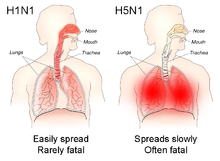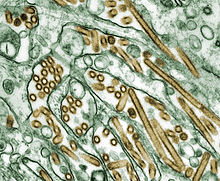Virus influenza A subtipe H5N1: Perbedaan antara revisi
k Bot: Perubahan kosmetika |
→Ikhtisar: Perbaika Tag: Suntingan perangkat seluler Suntingan peramban seluler |
||
| (15 revisi perantara oleh 7 pengguna tidak ditampilkan) | |||
| Baris 1: | Baris 1: | ||
'''H5N1''' adalah salah satu subtipe [[virus]] influenza A yang menyebabkan penyakit [[flu burung]]. Virus influenza A memiliki beberapa protein pada permukaannya, di antaranya protein [[hemaglutinin]] (disingkat H atau HA) serta protein [[neuraminidase]] (disingkat NA atau N). Kombinasi jenis protein H dan protein N akan menentukan sifat virus dan penamaan subtipe virus influenza. |
|||
| ⚫ | Virus H5N1 menimbulkan penyakit pada banyak spesies vertebrata, termasuk manusia, dan berpeluang menjadi [[pandemi influenza]]. Para ahli mengkhawatirkan bahwa H5N1 dapat bermutasi menjadi bentuk yang dapat menular dengan mudah dari manusia ke manusia, meskipun sampai sekarang belum ada kejadian kuat yang mendukung kekhawatiran itu. Mutasi seperti itu pernah terjadi ketika virus H2N2 berevolusi menjadi [[strain]] flu Hong Kong H3N2. |
||
| ⚫ | |||
| ⚫ | H5N1 is [[global spread of H5N1|widespread]] in the bird population. It is very easy for birds to catch avian flu from each other. Most humans known to have become infected had a lot of physical contact with infected birds, or, rarely, an infected relative. While H5N1 is mutating into variations which infect species not previously known to carry the virus, not all of these variations can infect humans. |
||
| ⚫ | A highly [[pathogen|pathogenic]] variation of H5N1 is currently spreading across the world from areas where it is [[endemic (epidemiology)|endemic]]. Migrating [[waterfowl]] (wild ducks, geese, and swans) carry H5N1, often without themselves becoming sick. {{ref|waterfowl}}{{ref|swans}} Avian flu is also spread through domestic [[poultry]], both through movements of infected birds and poultry products, and the use of infected poultry manure as fertiliser or feed. Humans with H5N1 have typically caught it from chickens, which were in turn infected by other poultry or waterfowl. |
||
| ⚫ | H5N1 is currently endemic in birds in southeast [[Asia]] and is threatening to become endemic in birds everywhere else. Tens of millions of birds have died of H5N1 influenza and hundreds of millions of birds have been slaughtered and disposed of to try to control the spread of the disease {{ref label|workshop|2|a}}. |
||
| ⚫ | Not all cases of human H5N1 infection are reported and consequently the exact mortality rate is unknown. Earlier historical [[Influenza pandemic|flu pandemics]], which were also believed to be of avian origin, had reportedly an average mortality rate of 2.5-5%. The current projected worst case scenario for a H5N1 pandemic is somewhere around 150 million human deaths directly due to H5N1 infection (or two to three percent of the world's human population). No one knows what the chances are for this worst case scenario. |
||
| ⚫ | |||
== Ikhtisar == |
|||
{| class="toccolours" cellpadding="0" cellspacing="0" style="float:right; clear:right; font-size:85%; width:400px; margin:0 0 1em 1em;" |
{| class="toccolours" cellpadding="0" cellspacing="0" style="float:right; clear:right; font-size:85%; width:400px; margin:0 0 1em 1em;" |
||
|- bgcolor="FF0000" |
|- bgcolor="FF0000" |
||
| Baris 5: | Baris 19: | ||
| colspan="2" | [[Berkas:Global spread of H5N1 map.PNG|pus|350px|Highly pathogenic H5N1]] |
| colspan="2" | [[Berkas:Global spread of H5N1 map.PNG|pus|350px|Highly pathogenic H5N1]] |
||
|- bgcolor=#FFEFEF |
|- bgcolor=#FFEFEF |
||
| style="width:10px; height:10px; background:#FF0000;" | || |
| style="width:10px; height:10px; background:#FF0000;" | || Negara-negara dengan kematian unggas akibat H5N1. |
||
|- bgcolor=#FFEFEF |
|- bgcolor=#FFEFEF |
||
| style="width:10px; height:5px; background:#800000;" | || |
| style="width:10px; height:5px; background:#800000;" | || Negara-negara dengan kematian manusia dan unggas akibat H5N1. |
||
|} |
|} |
||
<!-- {{H5N1}} --> |
<!-- {{H5N1}} --> |
||
H5N1 dianggap sebagai penyakit yang disebabkan oleh unggas, namun terdapat beberapa bukti terkait terbatasnya penularan virus dari manusia kesalahan |
|||
| ⚫ | |||
manusia.<ref>{{Cite journal|last=Ungchusak|first=Kumnuan|last2=Auewarakul|first2=Prasert|last3=Dowell|first3=Scott F.|last4=Kitphati|first4=Rungrueng|last5=Auwanit|first5=Wattana|last6=Puthavathana|first6=Pilaipan|last7=Uiprasertkul|first7=Mongkol|last8=Boonnak|first8=Kobporn|last9=Pittayawonganon|first9=Chakrarat|date=2005-01-27|title=Probable Person-to-Person Transmission of Avian Influenza A (H5N1)|url=https://doi.org/10.1056/NEJMoa044021|journal=New England Journal of Medicine|volume=352|issue=4|pages=333–340|doi=10.1056/NEJMoa044021|issn=0028-4793|pmid=15668219}}</ref> Faktor risiko tertularnya virus adalah dengan penanganan unggas yang terinfeksi, tetapi penularan virus dari unggas yang terinfeksi ke manusia dinyatakan tidak efisien.<ref>{{Cite web|url=http://people.scs.carleton.ca/~soma/biosec/readings/influenza/influenza.html|title=American Scientist Online - Influenza|last=editors@amsci.org|first=Science is a great adventure. American Scientist is the 90-year-old magazine of science and technology published by Sigma Xi, The Scientific Research Society. We are proud to work with distinguished contributors, photographers, researchers, academics and illustrators as chroniclers of that adventure. Contact|website=people.scs.carleton.ca|access-date=2019-02-14}}</ref> Para ahli telah mengidentifikasi peristiwa-peristiwa utama (menciptakan clades baru, menginfeksi spesies baru, menyebar ke daerah-daerah baru) menandai perkembangan virus flu burung menjadi pandemi, dan banyak dari peristiwa-peristiwa utama tersebut terjadi lebih cepat dari yang diperkirakan. |
|||
| ⚫ | |||
| ⚫ | H5N1 is [[global spread of H5N1|widespread]] in the bird population. It is very easy for birds to catch avian flu from each other. Most humans known to have become infected had a lot of physical contact with infected birds, or, rarely, an infected relative. While H5N1 is mutating into variations which infect species not previously known to carry the virus, not all of these variations can infect humans. |
||
== Tanda dan Gejala == |
|||
| ⚫ | A highly [[pathogen|pathogenic]] variation of H5N1 is currently spreading across the world from areas where it is [[endemic (epidemiology)|endemic]]. Migrating [[waterfowl]] (wild ducks, geese, and swans) carry H5N1, often without themselves becoming sick. {{ref|waterfowl}}{{ref|swans}} Avian flu is also spread through domestic [[poultry]], both through movements of infected birds and poultry products, and the use of infected poultry manure as fertiliser or feed. Humans with H5N1 have typically caught it from chickens, which were in turn infected by other poultry or waterfowl. |
||
Secara umum, masyarakat yang terjangkit flu biasanya memiliki gejala seperti deman, batuk, sakit tenggorokan, nyeri otot, permasalahan pada pernapasan dan [[Radang paru-paru|penumonia]]. Sedangkan tingkat keparahan tergantung pada seberapa parah orang tersebut terinfeksi. |
|||
== Terminologi == |
|||
| ⚫ | H5N1 is currently endemic in birds in southeast [[Asia]] and is threatening to become endemic in birds everywhere else. Tens of millions of birds have died of H5N1 influenza and hundreds of millions of birds have been slaughtered and disposed of to try to control the spread of the disease {{ref label|workshop|2|a}}. |
||
[[Berkas:H1N1 versus H5N1 pathology.png|jmpl|Perbandingan lokasi infeksi virus influenza subtipe H1N1 dan H5N1.]] |
|||
Isolat H5N1 diidentifikasi seperti contoh HPAI A (H5N1) A/chicken/Nakorn-Patom/Thailand/CU-K2/04 (H5N1): |
|||
| ⚫ | Not all cases of human H5N1 infection are reported and consequently the exact mortality rate is unknown. Earlier historical [[Influenza pandemic|flu pandemics]], which were also believed to be of avian origin, had reportedly an average mortality rate of 2.5-5%. The current projected worst case scenario for a H5N1 pandemic is somewhere around 150 million human deaths directly due to H5N1 infection (or two to three percent of the world's human population). No one knows what the chances are for this worst case scenario. |
||
| ⚫ | |||
[[Berkas:Influenza A - late passage.jpg|jmpl|200px|'''Influenza A virus''', the virus that causes Avian flu. Transmission [[electron micrograph]] of negatively stained virus particles in late passage. <ref>(''Sumber: Dr. Erskine Palmer, Centers for Disease Control and Prevention Public Health Image Library'').</ref>]] |
|||
* '''A''' sebagai genus dari tipe influenza ([[Influenzavirus A|A]], B, atau C). |
|||
| ⚫ | [[Berkas:Colorized transmission electron micrograph of Avian influenza A H5N1 viruses.jpg|jmpl|ka| |
||
* '''''Chicken''''' atau '''Ayam''' adalah spesies hewan tempat virus berkembang. |
|||
* '''Nakorn-Patom/Thailand''' adalah tempat virus diisolasi pertama kali. |
|||
* '''CU-K2''' adalah nomor referensi laboratorium yang mengidentifikasinya dari virus influenza lain yang diisolasi di tempat dan tahun yang sama. |
|||
* '''04''' mewakili tahun isolasi (2004). |
|||
* '''H5''' adalah jenis protein [[hemaglutinin]] nomor lima. |
|||
* '''N1''' adalah jenis protein [[neuraminidase]] nomor satu. |
|||
== Pencegahan == |
|||
| ⚫ | [[Berkas:Colorized transmission electron micrograph of Avian influenza A H5N1 viruses.jpg|jmpl|ka|Tampilan mikroskop transmisi elektron yang diwarnai untuk melihat H5N1 (warna emas) yang ditumbuhkan pada sel ginjal anjing Madin-Darby (hijau).<ref>(''Source: C. Goldsmith, J. Katz and S. Zaki. Centers for Disease Control & Prevention Public Health Image Library. Image #1841.'').</ref>]] |
||
Flu burung dapat dicegah dengan [[vaksinasi]] pada unggas yang berisiko serta melakukan komunikasi, informasi, dan edukasi (KIE) kepada masyarakat. |
|||
== Lihat pula == |
== Lihat pula == |
||
* [[ |
* [[Flu burung]] |
||
* [[Zoonosis]] |
|||
* [[National Influenza Centers]] |
|||
* [[Zoonosist]] |
|||
== Referensi dan pranala luar == |
== Referensi dan pranala luar == |
||
{{references}} |
{{references}} |
||
{{flu}} |
|||
[[Kategori:Epidemiologi]] |
|||
[[Kategori:Influenza]] |
[[Kategori:Influenza]] |
||
[[Kategori: |
[[Kategori:Orthomyxoviridae]] |
||
[[Kategori:Pandemik]] |
|||
Revisi terkini sejak 2 Januari 2023 06.27
H5N1 adalah salah satu subtipe virus influenza A yang menyebabkan penyakit flu burung. Virus influenza A memiliki beberapa protein pada permukaannya, di antaranya protein hemaglutinin (disingkat H atau HA) serta protein neuraminidase (disingkat NA atau N). Kombinasi jenis protein H dan protein N akan menentukan sifat virus dan penamaan subtipe virus influenza.
Virus H5N1 menimbulkan penyakit pada banyak spesies vertebrata, termasuk manusia, dan berpeluang menjadi pandemi influenza. Para ahli mengkhawatirkan bahwa H5N1 dapat bermutasi menjadi bentuk yang dapat menular dengan mudah dari manusia ke manusia, meskipun sampai sekarang belum ada kejadian kuat yang mendukung kekhawatiran itu. Mutasi seperti itu pernah terjadi ketika virus H2N2 berevolusi menjadi strain flu Hong Kong H3N2.
Ikhtisar
[sunting | sunting sumber]| Highly pathogenic H5N1 | |
|---|---|
 | |
| Negara-negara dengan kematian unggas akibat H5N1. | |
| Negara-negara dengan kematian manusia dan unggas akibat H5N1. | |
H5N1 dianggap sebagai penyakit yang disebabkan oleh unggas, namun terdapat beberapa bukti terkait terbatasnya penularan virus dari manusia kesalahan
manusia.[1] Faktor risiko tertularnya virus adalah dengan penanganan unggas yang terinfeksi, tetapi penularan virus dari unggas yang terinfeksi ke manusia dinyatakan tidak efisien.[2] Para ahli telah mengidentifikasi peristiwa-peristiwa utama (menciptakan clades baru, menginfeksi spesies baru, menyebar ke daerah-daerah baru) menandai perkembangan virus flu burung menjadi pandemi, dan banyak dari peristiwa-peristiwa utama tersebut terjadi lebih cepat dari yang diperkirakan.
Tanda dan Gejala
[sunting | sunting sumber]Secara umum, masyarakat yang terjangkit flu biasanya memiliki gejala seperti deman, batuk, sakit tenggorokan, nyeri otot, permasalahan pada pernapasan dan penumonia. Sedangkan tingkat keparahan tergantung pada seberapa parah orang tersebut terinfeksi.
Terminologi
[sunting | sunting sumber]
Isolat H5N1 diidentifikasi seperti contoh HPAI A (H5N1) A/chicken/Nakorn-Patom/Thailand/CU-K2/04 (H5N1):
- A sebagai genus dari tipe influenza (A, B, atau C).
- Chicken atau Ayam adalah spesies hewan tempat virus berkembang.
- Nakorn-Patom/Thailand adalah tempat virus diisolasi pertama kali.
- CU-K2 adalah nomor referensi laboratorium yang mengidentifikasinya dari virus influenza lain yang diisolasi di tempat dan tahun yang sama.
- 04 mewakili tahun isolasi (2004).
- H5 adalah jenis protein hemaglutinin nomor lima.
- N1 adalah jenis protein neuraminidase nomor satu.
Pencegahan
[sunting | sunting sumber]
Flu burung dapat dicegah dengan vaksinasi pada unggas yang berisiko serta melakukan komunikasi, informasi, dan edukasi (KIE) kepada masyarakat.
Lihat pula
[sunting | sunting sumber]Referensi dan pranala luar
[sunting | sunting sumber]- ^ Ungchusak, Kumnuan; Auewarakul, Prasert; Dowell, Scott F.; Kitphati, Rungrueng; Auwanit, Wattana; Puthavathana, Pilaipan; Uiprasertkul, Mongkol; Boonnak, Kobporn; Pittayawonganon, Chakrarat (2005-01-27). "Probable Person-to-Person Transmission of Avian Influenza A (H5N1)". New England Journal of Medicine. 352 (4): 333–340. doi:10.1056/NEJMoa044021. ISSN 0028-4793. PMID 15668219.
- ^ editors@amsci.org, Science is a great adventure. American Scientist is the 90-year-old magazine of science and technology published by Sigma Xi, The Scientific Research Society. We are proud to work with distinguished contributors, photographers, researchers, academics and illustrators as chroniclers of that adventure. Contact. "American Scientist Online - Influenza". people.scs.carleton.ca. Diakses tanggal 2019-02-14.
- ^ (Source: C. Goldsmith, J. Katz and S. Zaki. Centers for Disease Control & Prevention Public Health Image Library. Image #1841.).

